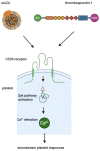Human CD36: Gene Regulation, Protein Function, and Its Role in Atherosclerosis Pathogenesis
- PMID: 40565598
- PMCID: PMC12192553
- DOI: 10.3390/genes16060705
Human CD36: Gene Regulation, Protein Function, and Its Role in Atherosclerosis Pathogenesis
Abstract
Human CD36 plays an important role in ligand binding, signalling, cell adhesion, and the regulation of angiogenesis. As a scavenging receptor, it is responsible for clearing long-chain fatty acids (LCFAs) and removing approximately 50% of oxidised low-density lipoprotein (ox-LDL) from plasma. The CD36 gene is alternatively spliced. It has several alternative promoters and first exons. The alternative transcripts are expressed in multiple tissues, and their expression patterns are highly variable. The molecular mechanisms that regulate CD36 gene expression are complex and reflect its multifunctional role in different tissues. CD36 activity has been linked to several metabolic processes, such as inflammation, angiogenesis, phagocytosis, and energy homeostasis. CD36 plays a key role in regulating vascular and cardiovascular health and in the pathogenesis of atherosclerosis. CD36 gene mutations in the Caucasian population are rare. Hence, it is extremely difficult to recruit a statistically significant group of CAD patients with these mutations. Nevertheless, this population is largely at risk of cardiovascular disease. Atherosclerosis is a multifactorial disease, but the role of the CD36 receptor in the development of ox-LDL is extremely important. This review aims to introduce readers to issues related to the relationship between CD36 and CAD. The activity of this receptor should be considered when exploring treatment options for atherosclerosis-related complications.
Keywords: CD36; atherosclerosis; ox-LDL receptor.
Conflict of interest statement
The author declares no conflicts of interest.
Figures
Similar articles
-
Single-incision sling operations for urinary incontinence in women.Cochrane Database Syst Rev. 2017 Jul 26;7(7):CD008709. doi: 10.1002/14651858.CD008709.pub3. Cochrane Database Syst Rev. 2017. Update in: Cochrane Database Syst Rev. 2023 Oct 27;10:CD008709. doi: 10.1002/14651858.CD008709.pub4. PMID: 28746980 Free PMC article. Updated.
-
A rapid and systematic review of the clinical effectiveness and cost-effectiveness of paclitaxel, docetaxel, gemcitabine and vinorelbine in non-small-cell lung cancer.Health Technol Assess. 2001;5(32):1-195. doi: 10.3310/hta5320. Health Technol Assess. 2001. PMID: 12065068
-
Home treatment for mental health problems: a systematic review.Health Technol Assess. 2001;5(15):1-139. doi: 10.3310/hta5150. Health Technol Assess. 2001. PMID: 11532236
-
Systemic pharmacological treatments for chronic plaque psoriasis: a network meta-analysis.Cochrane Database Syst Rev. 2021 Apr 19;4(4):CD011535. doi: 10.1002/14651858.CD011535.pub4. Cochrane Database Syst Rev. 2021. Update in: Cochrane Database Syst Rev. 2022 May 23;5:CD011535. doi: 10.1002/14651858.CD011535.pub5. PMID: 33871055 Free PMC article. Updated.
-
Health professionals' experience of teamwork education in acute hospital settings: a systematic review of qualitative literature.JBI Database System Rev Implement Rep. 2016 Apr;14(4):96-137. doi: 10.11124/JBISRIR-2016-1843. JBI Database System Rev Implement Rep. 2016. PMID: 27532314
References
Publication types
MeSH terms
Substances
LinkOut - more resources
Full Text Sources
Medical
Research Materials
Miscellaneous




